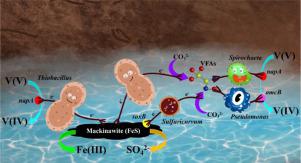Water Research ( IF 11.4 ) Pub Date : 2020-11-22 , DOI: 10.1016/j.watres.2020.116664 Chao He , Baogang Zhang , Jianping Lu , Rui Qiu

|
Mackinawite (FeS), a widely-distributed natural reducing mineral, can donate electron for various (bio)processes. However, little is known about mackinawite-driven chemoautotrophic bioreduction of toxic vanadate [V(V)] in aquifer. This study demonstrates that V(V) is successfully bioreduced by mackinawite under anaerobic condition via 150-d operation of constructed aquifer. Complete V(V) removal was achieved at the initial concentration of 10 mg/L and flow rate of 0.125 mL/min. Fluctuant hydrochemistry and hydrodynamics affected V(V) removal performance. Biotic activity was identified as the major contribution to V(V) transformation (76.4 ± 1.01%). Chemoautotrophic genera (e.g., Thiobacillus) could oxidize FeS coupled to direct V(V) reduction independently. Heterotrophic V(V) reducers (e.g., Pseudomonas and Spirochaeta) could also achieve V(V) detoxification by utilizing metabolic intermediates synthesized by autotrophic Fe(II) oxidizers (e.g., Thiobacillus) and S(-II) oxidizing genera (e.g., Sulfuricurvum). Gene abundance and enzymatic activity tests confirmed that nitrate reductase gene napA functioned crucially in chemoautotrophic V(V) reduction by Fe(II) and S(-II) donating electron. V(V) was reduced to insoluble V(IV) while elements in mackinawite were oxidized to Fe(III) and SO42−. This study reveals the coupling of iron, sulfur and vanadium in biogeochemical cycling, and offers a promising strategy for remediation of V(V)-polluted aquifer.
中文翻译:

硝酸还原酶在天然麦金石在含水层中化学自养钒酸盐转化中的新发现功能
Mackinawite(FeS)是一种分布广泛的天然还原性矿物,可以为各种(生物)过程捐赠电子。然而,关于含水层中有毒钒酸盐[V(V)]的麦基钠铁矿驱动的化学自养生物还原的了解甚少。这项研究表明,通过厌氧条件下的人造含水层150天操作,麦基钠长石成功地生物还原了V(V)。初始浓度为10 mg / L,流速为0.125 mL / min时,可以完全去除V(V)。波动的水化学和水动力学影响了V(V)的去除性能。生物活性被认为是对V(V)转化的主要贡献(76.4±1.01%)。化学自养属(例如,硫杆菌)可以氧化FeS并独立地直接还原V(V)。异养V(V)还原剂(例如,假单胞菌和螺旋体)也可以通过利用由自养的Fe(II)氧化剂(例如,合成的代谢中间体达到V(V)的解毒硫杆菌)和S(-II)氧化属(例如,Sulfuricurvum)。基因丰度和酶活性测试证实,硝酸还原酶基因napA在通过供体Fe(II)和S(-II)供电子的化学自养V(V)还原中起关键作用。V(V)还原为不溶性V(IV),而麦基钠长石中的元素氧化为Fe(III)和SO 4 2-。这项研究揭示了生物地球化学循环中铁,硫和钒的耦合,并为V(V)污染的含水层的修复提供了有希望的策略。











































 京公网安备 11010802027423号
京公网安备 11010802027423号